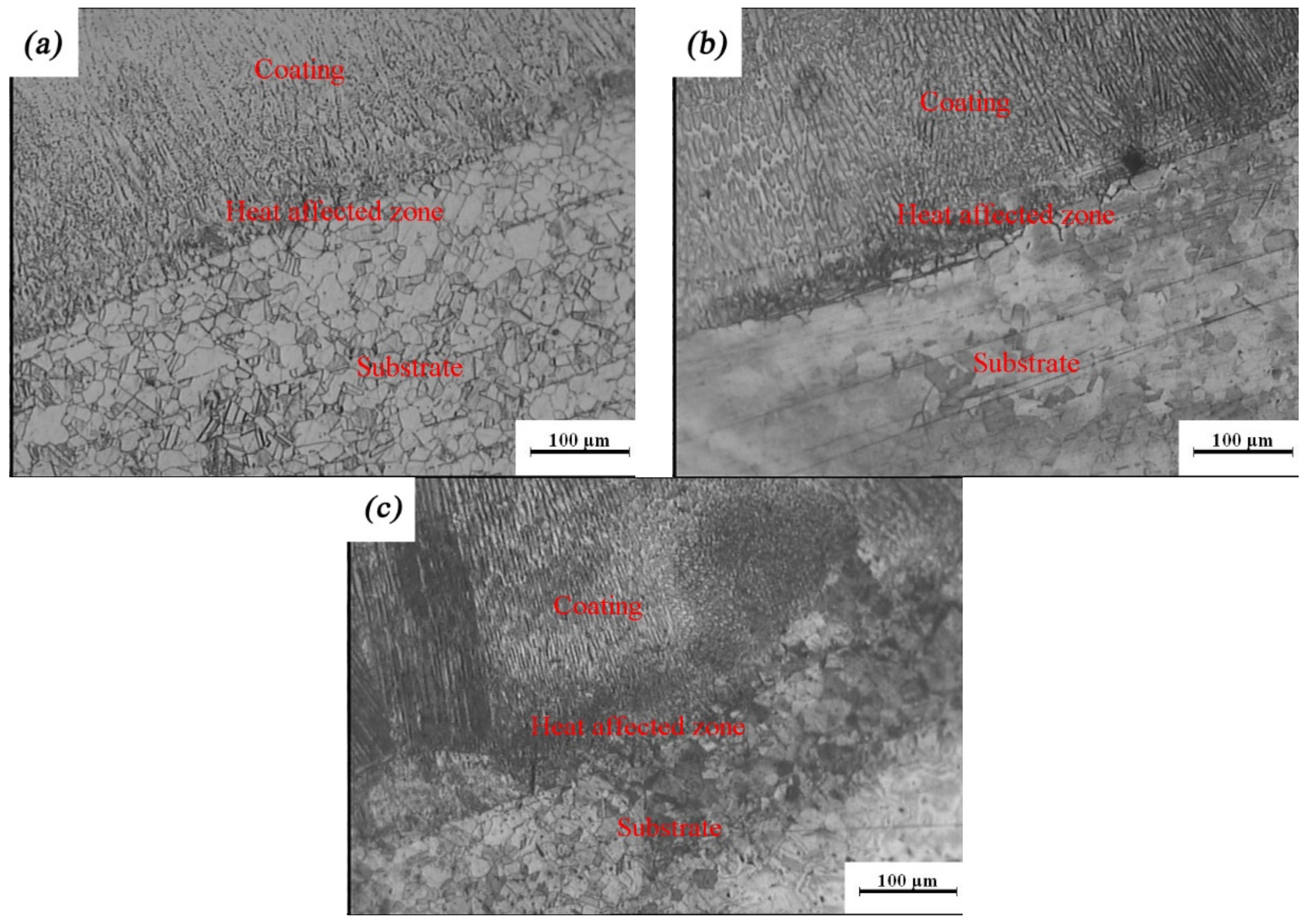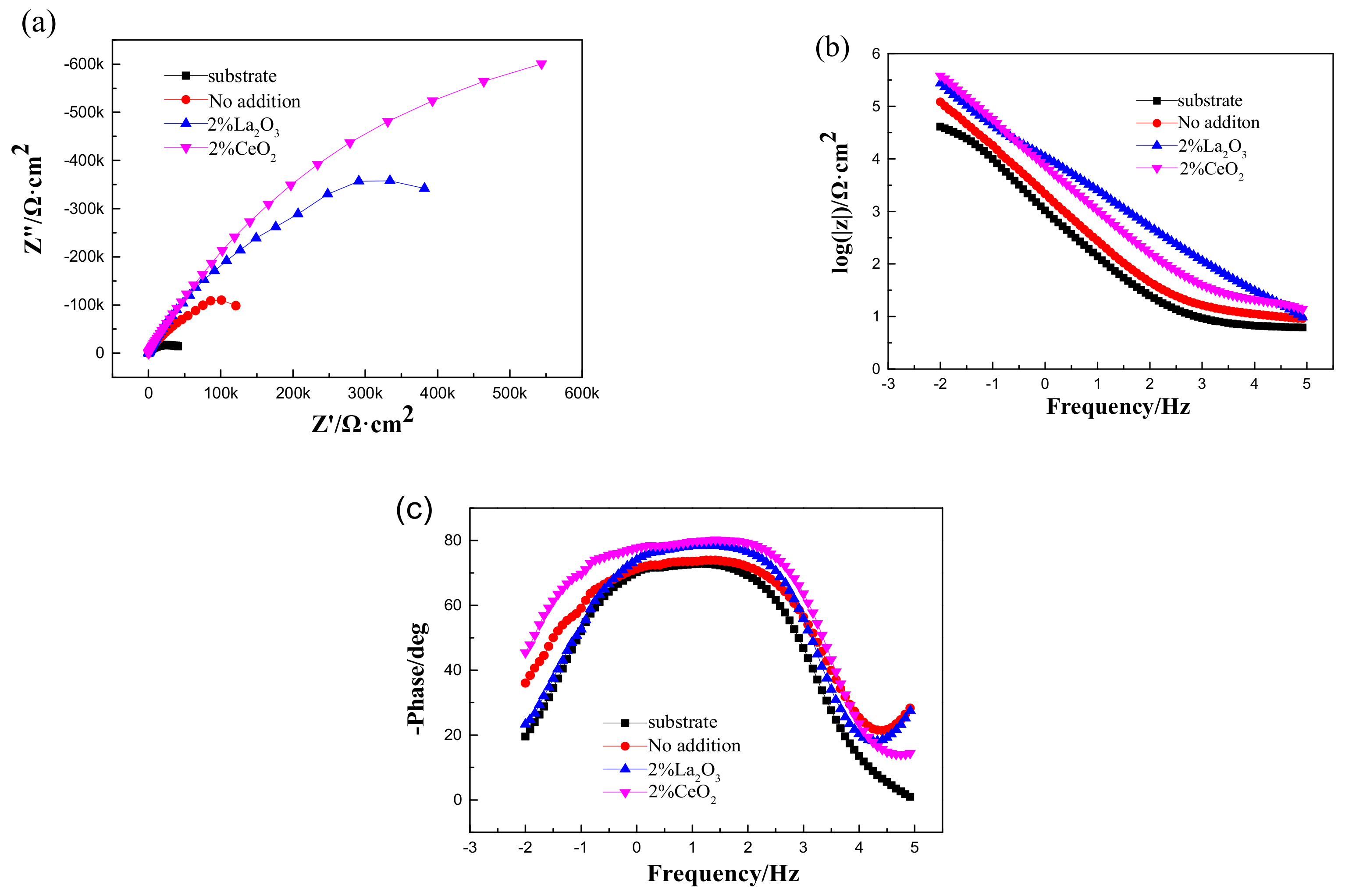Effect of Rare Earth Oxides on Microstructure and Corrosion Behavior of Laser-Cladding Coating on 316L Stainless Steel
Abstract
:1. Introduction
2. Experimental Methods
2.1. Preparation of Laser-Cladding Layer
2.2. Electrochemical Test and Surface Observation
3. Results and Discussion
3.1. XRD Analyses
3.2. Microstructure
3.3. Hardness Measurements
3.4. Electrochemical Studies
3.5. Salt Spray Tests
4. Conclusions
- Laser cladding is a promising surface modification technique that can not only increase the strength and hardness of the surface coating of 316L stainless steel through grain refinement but can also improve its corrosion resistance in harsh environments such as concentrated NaCl solutions;
- The modification of rare earth oxides on a laser-cladding layer can further increase hardness and corrosion resistance, and a CeO2-modified laser-cladding layer is better than one that is La2O3-modified.
Author Contributions
Funding
Acknowledgments
Conflicts of Interest
References
- Mohseni, E.; Zalnezhad, E.; Bushroa, A.R. Comparative investigation on the adhesion of hydroxyapatite coating on Ti-6Al-4V implant. Int. J. Adhes. Adhes 2014, 48, 238–257. [Google Scholar] [CrossRef]
- Wang, M.L.; Du, T.; Lu, X.L.; Le, K.X. Mechanism and application of trace rare earth elements in steel. Rare Earths 2001, 22, 37–40. [Google Scholar] [CrossRef]
- Garrison, W.M.; Maloney, J.L. Lanthanum additions and the toughness of ultra-high strength steels and the determination of appropriate lanthanum additions. Mater. Sci. Eng. A 2005, 403, 299–310. [Google Scholar] [CrossRef]
- Wang, L.M.; Lin, Q.; Yue, L.J.; Liu, L.; Guo, F.; Wang, F.M. Study of application of rare earth elements in advanced low alloy steels. J. Alloys Compd. 2008, 451, 534–537. [Google Scholar] [CrossRef]
- Xu, Z.Z.; Wang, Z.Y.; He, Z.J.; Zhang, J.W. Influence of laser power on microstructure and properties of laser cladding CeO2 modified 316L coating. Rare Metal 2019, 6, 18–23. [Google Scholar] [CrossRef]
- Kim, S.T.; Jeon, S.H.; Lee, I.S.; Park, Y.S. Effects of rare earth metals addition on the resistance to pitting corrosion of super duplex stainless steel–Part 1. Corros. Sci. 2010, 52, 1897–1904. [Google Scholar] [CrossRef]
- Zhang, H.; Zou, Y. Microstructure and properties of Fe-based composite coating by laser cladding Fe-Ti-V-Cr-C-CeO2 powder. Opt. Laser Technol. 2015, 65, 119–125. [Google Scholar] [CrossRef]
- Xing, H.; Dejun, K.; Renguo, S. Microstructures and properties of laser cladding Al-TiC-CeO2 composite coatings. Materials 2018, 11, 198. [Google Scholar] [CrossRef]
- Jawwad, A.K.A.; Mahdi, M.; Alshabatat, N. The role of service-induced residual stresses in initiating and propagating stress corrosion cracking (SCC) in a 316 stainless steel pressure-relief-valve nozzle set. Eng. Fail. Anal. 2019, 105, 1229–1251. [Google Scholar] [CrossRef]
- He, B.; Zhang, L.; Zhu, Q.; Wang, J.; Yun, X.; Luo, J.; Chen, Z. Effect of solution treated 316L layer fabricated by laser cladding on wear and corrosive wear resistance. Opt. Laser Technol. 2020, 121, 105788. [Google Scholar] [CrossRef]
- Zhang, Y.; Liu, Y.; Li, K.; Tong, H.; Feng, C.; Zhang, H.; Wang, H. Study on pitting characteristics of 304 stainless steel in atmospheric environment of the South China Sea. Surf. Technol. 2018, 47, 44–50. (In Chinese) [Google Scholar]
- Dong, H.Y.; Hu, L.J.; Liang, W.Y.; Xie, Y.P.; Lin, B.Q. Effect of rare earth Ce on corrosion resistance of 316L stainless steel. Corros. Sci. Prot. Technol. 2018, 30, 489–495. (In Chinese) [Google Scholar]
- Zhong, X.K.; Wang, X.F.; Han, F.S. Electrochemical corrosion behavior of laser cladding stellite-F alloy layer on 316L stainless steel surface. Heat Treat. Metals 2019, 44, 176–179. (In Chinese) [Google Scholar]
- Chen, J.; Zhou, Y.; Shi, C.; Mao, D. Microscopic analysis and electrochemical behavior of Fe-based coating produced by laser cladding. Metals 2017, 7, 435. [Google Scholar] [CrossRef]
- Zhang, H.; Zou, Y.; Zou, Z.; Zou, Z.D.; Shi, C.W. Effects of CeO2 on microstructure and corrosion resistance of TiC-VC reinforced Fe-based laser cladding layers. J. Rare Earths 2014, 32, 1095–1100. [Google Scholar] [CrossRef]
- Ye, S.Y.; Liu, J.Y.; Yang, W. Study on microstructure and properties of laser cladding 316L stainless steel coating. Surf. Technol. 2018, 47, 48–53. [Google Scholar] [CrossRef]
- Cao, Y.L. Study on Microstructure and Properties of Laser Cladding Co/Rare Earth Coating on 316L Stainless Steel Surface. Ph.D. Thesis, Jilin University, Jilin, China, 2015. [Google Scholar]
- Liu, N.M.; Zhang, Z.W.; Zhang, Y.; Cui, Y.; Chen, D.; Zhao, Y.; Xu, S.S.; Guo, H. Effects of Ce addition on the microstructure and mechanical properties of accident-tolerance Fe-Cr-Al fuel cladding materials. In Proceedings of the TMS Meeting & Exhibition, Phoenix, AZ, USA, 11–15 March 2018; pp. 61–71. [Google Scholar] [CrossRef]
- Niu, L.Y.; Cao, Y.L.; Tong, X.; Lin, J.X.; Li, G.Y.; Wang, W.Q. Effect of CeO2 on microstructure and corrosion resistance of laser cladding Co-based composite coating on 316L stainless steel. Appl. Laser 2015, 35, 304–308. [Google Scholar] [CrossRef]
- Song, X.; Yan, H.; Chen, F. Impact of rare earth element la on microstructure and hot crack resistance of ADC12 alloy. J. Wuhan Univ. Technol. Mater. Sci. Ed. 2018, 33, 193–197. [Google Scholar] [CrossRef]
- Zhao, Y.C.; He, W.; Zhang, J.R. Effect of laser power on temperature field of laser remelted cermet coating. Hot Work Technol. 2019, 48, 117–122. (In Chinese) [Google Scholar]
- Fan, L.; Chen, H.Y.; Dong, Y.H.; Dong, L.H.; Yin, Y.S. Wear and corrosion resistance of laser-cladded Fe-based composite coatings on AISI 4130 steel. Int. J. Miner. Metall. Mater. 2018, 25, 716–728. [Google Scholar] [CrossRef]
- Liu, X.B.; Yu, R.L. Effects of La2O3 on microstructure and wear properties of laser clad γ/Cr7C3/TiC composite coatings on TiAl intermatallic alloy. Mater. Chem. Phys. 2007, 101, 448–454. [Google Scholar] [CrossRef]
- Li, C.F. Study on Corrosion Residual Strength of Rare Earth Ce Modified AZ91D Magnesium Alloy. Ph.D. Thesis, Jilin University, Jilin, China, 2010. [Google Scholar]
- Zhou, S.F.; Dai, X.Q.; Zheng, H.Z. Microstructure and wear resistance of Fe-based WC coating by multi-track over-lapping laser induction hybrid rapid cladding. Opt. Laser Technol. 2012, 44, 190–197. [Google Scholar] [CrossRef]
- Zhang, P.; Li, S.X.; Zhang, Z.F. General relationship between strength and hardness. Mater. Sci. Eng. A 2011, 529, 62–73. [Google Scholar] [CrossRef]
- Abdulwahhab, Y.; Pojtanabuntoeng, T.; Kinsella, B.; Veder, J.P.; Barifcani, A. Comparison of corrosion behaviour and passive film properties of 316L austenitic stainless steel in CO2 and N2 environments. Corros. Eng. Sci. Technol. 2019, 54, 10–21. [Google Scholar] [CrossRef]
- Wang, Z.; Zhang, L.; Zhang, Z.R.; Lu, M.X. Combined effect of pH and H2S on the structure of passive film formed on Type 316L stainless steel. Appl. Surf. Sci. 2018, 458, 686–699. [Google Scholar] [CrossRef]
- Xu, H.Z. Study on the Re-Passivation Behavior of 316L Stainless Steel and the Stability of Passivation Film. Ph.D. Thesis, University of Science and Technology Beijing, Beijing, China, 2016. [Google Scholar]
- Zhao, T.; Cai, X.; Wang, S.X.; Zheng, S.A. Effect of CeO2 on microstructure and corrosive wear behavior of laser-cladded Ni/WC coating. Thin Solid Films 2000, 379, 128–132. [Google Scholar] [CrossRef]
- Wei, M. Effect of Rare Earth Oxide CeO2 on Microstructure and Properties Of Laser-Clad Cobalt-Based Alloy of H13 Steel. Ph.D. Thesis, Harbin Institute of Technology, Harbin, China, 2018. [Google Scholar]









| Composition | C | Mn | P | S | Si | Cr | Ni | Fe |
|---|---|---|---|---|---|---|---|---|
| Content | 0.03 | 1.3 | 0.006 | 0.006 | 0.46 | 16.06 | 10.01 | 72.128 |
| Coating | Corrosion Potential Ecorr/V | Current Density icorr/μA·cm−2 | Pitting Potential Epit/V |
|---|---|---|---|
| Substrate | −0.304 | 0.563 | >0.2 |
| Nothing added | −0.221 | 0.316 | 0.25 |
| 2% CeO2 | −0.175 | 0.112 | 0.06 |
| 2% La2O3 | −0.290 | 0.125 | 0.08 |
| Substrate | Nothing Added | CeO2 | La2O3 | |
|---|---|---|---|---|
| Rs/Ω·cm2 | 6.218 | 6.877 | 4.896 | 5.501 |
| Rct/Ω·cm2 | 46,120 | 134,300 | 304,100 | 235,200 |
| N | 0.8021 | 0.8089 | 0.8805 | 0.8642 |
| Y0/Ω−1 cm2·s−n | 1.0818 × 10−4 | 6.789 × 10−5 | 3.509 × 10−5 | 4.483 × 10−5 |
© 2019 by the authors. Licensee MDPI, Basel, Switzerland. This article is an open access article distributed under the terms and conditions of the Creative Commons Attribution (CC BY) license (http://creativecommons.org/licenses/by/4.0/).
Share and Cite
Xu, Z.; Wang, Z.; Chen, J.; Qiao, Y.; Zhang, J.; Huang, Y. Effect of Rare Earth Oxides on Microstructure and Corrosion Behavior of Laser-Cladding Coating on 316L Stainless Steel. Coatings 2019, 9, 636. https://doi.org/10.3390/coatings9100636
Xu Z, Wang Z, Chen J, Qiao Y, Zhang J, Huang Y. Effect of Rare Earth Oxides on Microstructure and Corrosion Behavior of Laser-Cladding Coating on 316L Stainless Steel. Coatings. 2019; 9(10):636. https://doi.org/10.3390/coatings9100636
Chicago/Turabian StyleXu, Zezhou, Zhiying Wang, Jian Chen, Yanxin Qiao, Junwei Zhang, and Yueming Huang. 2019. "Effect of Rare Earth Oxides on Microstructure and Corrosion Behavior of Laser-Cladding Coating on 316L Stainless Steel" Coatings 9, no. 10: 636. https://doi.org/10.3390/coatings9100636





